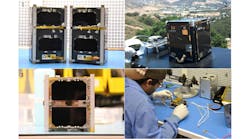NASA’s Educational Launch of Nanosatellite (ElaNa) missions, which are conducted under the CubeSat Launch Initiative, give students and teachers hands-on experience developing flight hardware. While providing a low-cost research avenue, the cube-shaped miniature satellites give students and teachers a chance to address a variety of space as well as science, technology, engineering, and math (STEM) missions. Since the program’s inception in 2010, over 90 satellites have been selected—including these four CubeSats launched as part of the fifth ElaNa mission.
Each of the four student-built satellites will gather information for its own specific mission. CUNYSAT-1, developed by students at Medgar Evers College (New York), will investigate ionospheric density disturbances by measuring GPS signal changes. In contrast, the Intelligent Payload Experiment (IPEX) satellite, which was created by students at the Jet Propulsion Laboratory (JPL) at the California Institute of Technology, will help to validate various intelligent-payload-module (IPM) technologies. This includes downlink operations, automated ground operations, and autonomous on-board instrument processing.
The Multipurpose Mini-satellite (M-Cubed-2) from students at the University of Michigan will obtain mid-resolution color imagery of the Earth’s surface. Because it carries the JPL-developed CubeSat On-board Processing Validation Experiment, it also will test next-generation technology for real-time, high-data-rate instrument processing. (This is the second M-Cubed satellite, as the original unintentionally become attached to another CubeSat after launch and lost the ability to transmit data.)
The final cubesat in this launch is dubbed FIREBIRD, which is short for Focused Investigations of Relativistic Electron Burst, Intensity, Range and Dynamic. It was developed by students at Montana State University and the University of New Hampshire. FIREBIRD’s goal is to help provide insight into acceleration and loss processes in the outer Van Allen Radiation Belt.
NASA recently announced the fifth round of CubeSat mission candidates—16 satellites from nine states that will fly as auxiliary payloads throughout 2015, 2016, and 2017. Organizations sponsoring the CubeSats include Boston University, Brown University, the University of California, the University of Michigan, Johns Hopkins Applied Physics Laboratory, and the Aerospace Corp., among others.
Each CubeSat measures approximately 4 in. on each side, has a volume of about 1 qt., and weighs less than 3 lbs. These four CubeSats follow 11 other student-built satellites, which were launched in December 2013 as part of the initiative under ElaNA’s fourth mission. At that point, PhoneSat 2.4 also was launched to test the use of commercial-off-the-shelf (COTS) components in spacecraft for extended periods of time. Another call for CubeSat proposals will be announced by NASA in mid-August 2014.
